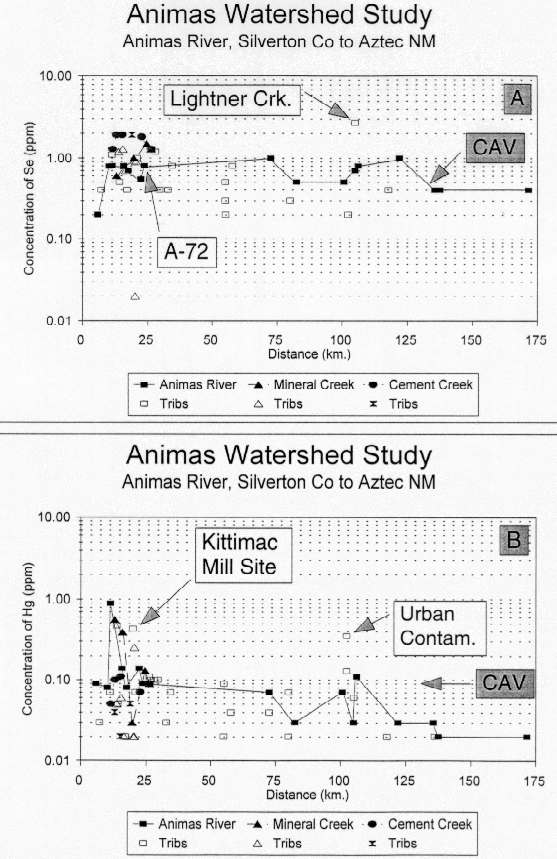The colloidal component dominates the leachable chemistry component of the bed sediments. Aggregated colloidal material is deposited during the low-flow cycle like a blanket on the stream bed and adds a substantial amount of metal to the bed sediments (fig. 18). The mass transfer of metals, as shown by the loss of dissolved and colloidal loads, is an indication that the bed sediments are gaining metals. The constant concentration ratios of iron to zinc in the colloids and in the 2M HCl-H2O2 digestions of the bed sediments are a measure of the intimate mixing between colloids and bed sediments downstream from Silverton. Upstream from Silverton and downstream from Cement Creek, the ratios did not agree. Downstream from Mineral Creek, however, after colloids had settled from the Animas River and zinc had sorbed to them, the ratios agreed very well. In fact, the iron to zinc ratios were comparable for a 100-km reach of the Animas River(fig. 31A). The close agreement in the iron to zinc ratio indicates that the iron hydroxide component digested from the bed sediments was essentially the same as the colloidal material. Some part of the colloidal material that settled to the stream bed had become part of the bed sediment coatings.
A similar correspondence of concentration ratios between colloids and bed sediments occurred for the ratios of aluminum (fig. 31B) and copper (fig. 31C) with respect to zinc, although the agreement is not as striking. The amount of aluminum deposition from water to bed sediments downstream from the confluence of Mineral Creek was about 260 kg/day. This amount of deposition had a substantial influence on the chemistry of the iron hydroxide fraction of the bed sediments, and thus the metal ratios in the colloids and the bed sediments varied together.
 Figure 30. Metal distribution profiles for selenium (Se) and mercury (Hg) for the Animas River below Silverton
Figure 30. Metal distribution profiles for selenium (Se) and mercury (Hg) for the Animas River below SilvertonComparisons of the yields from samples collected at the same sites in both 1995 and 1996 indicates that the metals associated with the iron-hydroxide phases, that is copper, lead, and zinc in particular, are enriched in the 1996 data set from 10-50 percent over what these same sites were in 1995. This indicates that the hydrograph affects the amount of colloidal component that accumulates at any given site during the year. The snowpack in 1996 was low and the resulting low-volume spring runoff may not have completely flushed the streams of cumulated colloidal components (fig. 9). Whereas the general form of the metal profiles from year-to-year are the same, it would be difficult to use the sediment samples as a monitoring tool to evaluate the effects of remediation because of the variability caused by this flushing process (see appendix VII). Water chemistry probably provides a better monitoring tool because it provides an instanteous measure of metals in the stream whereas the sediment sample provides a variable, annual integrated measure of the metals in the streams.